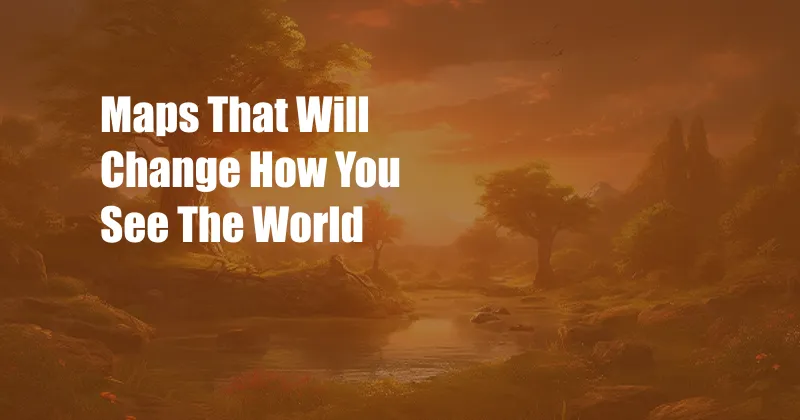
Maps That Will Change How You See the World
In the realm of cartography, maps have long served as indispensable tools for navigating our surroundings and understanding our place within the world. From ancient parchment scrolls to intricate digital creations, maps have continually evolved, ushering in new perspectives and transforming our comprehension of the globe.
Today, maps continue to push boundaries, extending their reach far beyond traditional geographical representations. With the advent of digital technology and the integration of innovative data sources, a new generation of maps is emerging, promising to redefine the way we perceive and interact with the world.
The Rise of Interactive Maps
The advent of interactive maps has catapulted cartography into a new era, empowering users with unprecedented control and customization. These dynamic maps allow us to manipulate data, zoom in on specific areas, and explore layers of information that were previously inaccessible.
Interactive maps have revolutionized fields such as urban planning, disaster management, and historical research. For example, city planners can use interactive maps to visualize traffic patterns, identify areas for development, and engage with stakeholders in a more immersive way. Similarly, disaster relief organizations can utilize interactive maps to track the spread of natural disasters, allocate resources effectively, and coordinate response efforts.
Data-Driven Maps
The availability of vast amounts of data has fueled the development of data-driven maps. These maps harness the power of data analytics to visualize complex patterns, relationships, and insights that would otherwise remain hidden.
Data-driven maps have opened up new possibilities in fields such as public health, economics, and social sciences. For instance, health organizations can use data-driven maps to identify disease hotspots, track the spread of epidemics, and target interventions more effectively. Economists can leverage data-driven maps to analyze market trends, identify areas of economic growth, and inform investment decisions.
Augmented Reality and Virtual Reality Maps
Augmented reality (AR) and virtual reality (VR) are transforming the way we interact with maps. AR maps overlay digital information onto the real world, providing users with a mixed reality experience. VR maps, on the other hand, create immersive environments that allow users to explore locations and data in a fully virtual setting.
AR and VR maps have the potential to revolutionize navigation, education, and entertainment. For example, AR maps can guide tourists through unfamiliar cities, providing real-time information and directions. VR maps can transport students to historical sites, allowing them to experience the past in a more interactive way. Additionally, AR and VR maps can enhance gaming and entertainment experiences, creating immersive and engaging virtual worlds.
Tips and Expert Advice for Navigating the Future of Maps
As the world of maps continues to evolve, here are some tips and expert advice to help you navigate the future:
- Embrace Interactivity: Explore interactive maps to gain a deeper understanding of the world around you. Customize layers, zoom in on specific areas, and engage with data in a dynamic way.
- Leverage Data: Seek out data-driven maps to uncover hidden patterns and insights. Analyze data to make informed decisions, identify trends, and gain a competitive edge.
- Explore New Technologies: Keep up with the latest advancements in AR and VR maps. Integrate these technologies into your work and personal life to unlock new possibilities and enhance your experiences.
By embracing these tips, you can stay ahead of the curve in the rapidly evolving world of maps. These tools will empower you to visualize the world in new ways, gain deeper insights, and navigate the future with confidence.
FAQ on the Future of Maps
Q: How will interactive maps impact our daily lives?
A: Interactive maps will make it easier for us to navigate our surroundings, engage with information, and make informed decisions. They will empower us to explore the world in a more personalized and immersive way.
Q: What are the advantages of data-driven maps?
A: Data-driven maps can reveal hidden patterns, trends, and insights that were previously inaccessible. They help us understand complex issues, identify opportunities, and make better decisions.
Q: How will AR and VR maps change the way we interact with the world?
A: AR and VR maps will create immersive experiences that enhance navigation, education, and entertainment. They will allow us to explore locations, visualize data, and interact with the world in new and exciting ways.
Conclusion
As we venture into the future, maps will continue to shape the way we perceive and understand our surroundings. Interactive maps, data-driven maps, and AR and VR maps promise to revolutionize the world of cartography, unlocking new possibilities and transforming our experiences. By embracing these advancements, we can unlock the full potential of maps, gain deeper insights, and navigate the future with greater clarity and confidence.
Are you excited about the future of maps? Share your thoughts and questions in the comments below!